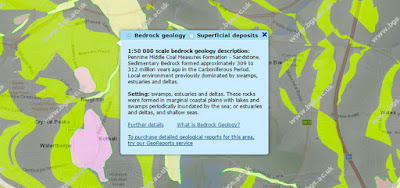 |
| The Primitive Methodist Church in Beighton |
Having undertaken surveys of the geology, mediaeval churches and various historic buildings that are set on or near to the known outcrop of “Rotherham Red” sandstone – from Hooton Roberts to Harthill – I took advantage of a rare shopping trip to Crystal Peaks shopping centre and walked around the village of Beighton.
 |
| A geological map of the area around Beighton |
Set on an unnamed Pennine Middle Coal Measures Formation sandstone, of similar age to those already encountered in the villages of Wales and Treeton, I wasn't surprised to discover that the various historic buildings here are constructed of yellow/buff/brown sandstone, with some iron stained bands – typical of the Coal Measures sandstones.
 |
| Victorian houses with thin bedded sandstone walling |
In very many quarries excavated into these sandstones, a section through the quarry face will show a succession of beds of various thickness and grain size – with the massive beds being selected for the principal structural elements and finer, thinner beds being used for general walling.
 |
| An old quarry in Beighton |
Getting off the bus on Robin Road, the Primitive Methodist Church provides a good example of this style of construction, as do the various Victorian terraced houses that run alongside High Street; however, the oldest houses – which include those of the more wealthy landowners – are generally built entirely in massive, medium grained sandstone.
 |
| A Georgian house built out of massive, medium grained sandstone |
Having had a good wander around the old village of Beighton – and taking good note of its topography - I then set off to explore the church of St. Mary the Virgin.
No comments:
Post a Comment